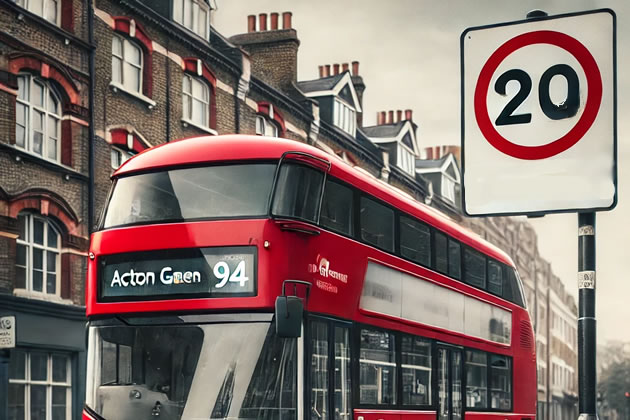Mayor Denies 20mph Limits are Slowing Buses
Says that junction delays main reason for longer journey times

Mayor says that decrease in bus speeds since before the pandemic is 'negligible'
February 24, 2025
Sir Sadiq Khan has insisted that the roll-out of 20mph limits on roads across the capital is not slowing down average bus speeds, despite the fact that buses remain slightly slower than they were pre-pandemic.
In answer to a recent written question, the Mayor said it was “unlikely” that the rising number of 20mph roads was having more than a “negligible” impact on bus speeds – as “overall journey times are largely dictated by junction delays”.
As part of Sir Sadiq’s ‘Vision Zero’ strategy – which aims to eliminate all deaths and serious injuries from London’s transport network by 2041 – Transport for London (TfL) has increased the number of 20mph limits on roads it controls, so that some 264km are now subject to the speed cap.
But Tories on the London Assembly argue that the policy has caused unnecessary delays on buses, creating a “long-term cycle of decline” where buses become less attractive to Londoners because of how slow they are, and consequently less financially viable for TfL – leading to routes being cut.
Neil Garratt, leader of City Hall Conservatives, wrote to Sir Sadiq: “There’s clear evidence that bus speeds are declining across London. What work have you done to determine whether lowering speed limits is a possible factor?”
The mayor replied: “The average bus speed in London in 2019-20 was 9.29 mph and in 2023-24 was very similar at 9.27 mph – a very small decline of 0.02.
“However, as a customer there is a perception of declining bus speeds following returning traffic and roadworks after the Covid-19 period.”
A report by the watchdog London Travelwatch revealed in November last year that in parts of central London, bus speeds have dropped below 7mph.
The research found that average bus speeds range from 8.1mph in inner London to 10.3mph in outer London. Bus speeds were lower in every borough in 2023/24 compared with 10 years previously. In the ‘square mile’ of the City of London, buses travel at only 6.6mph – and at 7.1mph in Westminster and in Camden, the report said.
In his written answer to Mr Garratt, Sir Sadiq continued, “Lowering speeds is one of the most important things that can be done to make our streets safer.
“Over half of London’s roads now have a 20mph speed limit and London’s boroughs continue to lead the way with 19 of the 33 boroughs now having 20mph speed limits across their roads.
“In 2020, we reduced the speed limit on all TfL roads within the central London Congestion Charging zone to 20mph, with preliminary data showing a 24.9 per cent reduction in fatal and serious injuries post implementation.”
On the question of whether average bus speeds are being impacted, the Mayor added: “Due to current average speeds, it is unlikely that the lowering of speed limits from 30mph to 20mph will change existing journey times during the day.
“During off-peak periods, including overnight, some people may experience a slight increase in journey times, however research into the impacts of 20mph by Steer Davies Gleave suggests that introducing 20mph speed limits has a negligible impact on journey times, given that overall journey times are largely dictated by junction delays and not vehicle speeds.”
In a pledge to speed up the capital’s buses, the Mayor said: “I fully recognise the importance and scale of the challenge involved in improving bus journey times and reliability.
“That is why TfL is working in partnership with bus operators and their borough colleagues to deliver a programme of technological, operational and policy improvements to better support bus performance while also delivering my Vision Zero ambition.”
Noah Vickers - Local Democracy Reporter
Like Reading Articles Like This? Help Us Produce More This site remains committed to providing local community news and public interest journalism. Articles such as the one above are integral to what we do. We aim to feature as much as possible on local societies, charities based in the area, fundraising efforts by residents, community-based initiatives and even helping people find missing pets. We've always done that and won't be changing, in fact we'd like to do more. However, the readership that these stories generates is often below that needed to cover the cost of producing them. Our financial resources are limited and the local media environment is intensely competitive so there is a constraint on what we can do. We are therefore asking our readers to consider offering financial support to these efforts. Any money given will help support community and public interest news and the expansion of our coverage in this area. A suggested monthly payment is £8 but we would be grateful for any amount for instance if you think this site offers the equivalent value of a subscription to a daily printed newspaper you may wish to consider £20 per month. If neither of these amounts is suitable for you then contact info@neighbournet.com and we can set up an alternative. All payments are made through a secure web site. One-off donations are also appreciated. Choose The Amount You Wish To Contribute. If you do support us in this way we'd be interested to hear what kind of articles you would like to see more of on the site – send your suggestions to the editor. For businesses we offer the chance to be a corporate sponsor of community content on the site. For £30 plus VAT per month you will be the designated sponsor of at least one article a month with your logo appearing if supplied. If there is a specific community group or initiative you'd like to support we can make sure your sponsorship is featured on related content for a one off payment of £50 plus VAT. All payments are made through a secure web site. |